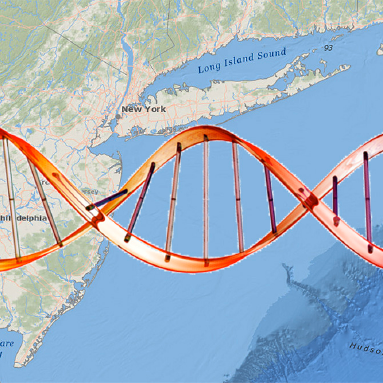Fishers, children, and scientists have dreamed forever of sampling the oceans’ free-ranging animals without the need to capture or even observe them red-handed. We stand on the beach or a boat and dream of wearing magic goggles that allow us to know the diversity, distribution, and abundance of marine life.
About 20 years ago, researchers glimpsed the realization of the dream, when they appreciated that animals shed DNA in aquatic environments, and that studies of these genetic fragments, known as environmental or eDNA, might provide the evidence from which we could conjure accurate, timely descriptions of marine life.
Beginning in 2015, we have tested this emerging technology in more than 1000 samples from marine and freshwater environments, many from waters around New York City. In 2017 we demonstrated eDNA from 1 liter water samples was sufficient to detect seasonal movements and habitat preference of fish in New York Harbor. In 2018, we hosted the first US National Conference on Marine eDNA. Our eDNA work includes new methods aimed at encouraging high school student participation and detection of overlooked subtropical fish in coastal New Jersey. In 2020 we published the first large-scale comparison of eDNA with a traditional trawl survey. With support from NOAA, our current efforts aim to improve accessibility, affordability, and reliability of core methods in marine eDNA metabarcoding.
We have recently shown that current laboratory protocols optimize sensitivity and reproducibility, especially for more abundant fish populations (ICES J Mar Sci 2022a). We conclude that eDNA rarity poses the main challenge to current methods and that this can be addressed by sampling larger water volumes. eDNA metabarcoding has generally been considered best suited for presence/absence assessment rather than as a measure of abundance. We demonstrated that spiking metabarcoding PCRs with an exogenous DNA standard enables accurate measurement of eDNA copy numbers for multiple species in a single sample, potentially streamlining survey effort (ICES J Mar Sci 2022b). We are currently working with New Jersey Bureau of Marine Fisheries to compare eDNA levels to numbers of fish caught by shoreline seining in 2023-2024 Raritan Bay Seine Survey. On February 28, 2024 we presented our fourth webinar in NOAA Omics series entitled “eDNA-dominant species characterize coastal habitats” an approach with potentially wide applications in marine biogeography and ocean monitoring. Our current research is supported by NOAA Award Number NA23OAR0110593.
Our work in this area is ongoing.
Publications about Aquatic environmental DNA (eDNA)
. A potential tool for marine biogeography: eDNA-dominant fish species differ among coastal habitats and by season concordant with gear-based assessments [external link]. Plos One vol. 19(11): e0313170., 2024
. Human and domesticated animal environmental DNA as bioassays of the Anthropocene [external link]. The Innovation 4 (1): 100356, 2023 https://doi.org/10.1016/j.xinn.2022.100356 eDNA; human and domesticated animal DNA; biomarker; anthropocene
. 12S gene metabarcoding with DNA standard quantifies marine bony fish environmental DNA, identifies threshold for reproducible detection, and overcomes distortion due to amplification of non-fish DNA (PDF). , . DOI: 10.1002/edn3.376 (11 November): 2022 bottom trawl survey, coastal ecosystem, eDNA, environmental DNA, marine fish, metabarcoding, quantitative metabarcoding
. Current laboratory protocols for detecting fish species with environmental DNA optimize sensitivity and reproducibility, especially for more abundant populations [external link]. ICES Journal of Marine Science vol. fsab273, 2022 https://doi.org/10.1093/icesjms/fsab273
. Interspecific allometric scaling in eDNA production among northwestern Atlantic bony fishes reflects physiological allometric scaling (PDF). Environmental DNA 2022 DOI: 10.1002/edn3.381 abundance, allometric scaling, allometry, biomass, eDNA, fishes
. Biological information for the new blue economy and the emerging role of eDNA (PDF). Chapter 13 (pp. 249-258) in Preparing a Workforce for the New Blue Economy: People, Products, and Policies, . Elsevier, 2021 https://doi.org/10.1016/B978-0-12-821431-2.00030-5 aquatic eDNA
. How eDNA Could be a Cornerstone of the New Blue Economy (PDF). Maritime Executive 2021
. Archiving time series sewage samples as biological records of built environments [external link]. BMC Infectious Diseases 21 (601): 2021
. Improved Environmental DNA Reference Library Detects Overlooked Marine Fishes in New Jersey, United State [external link]. Frontiers in Marine Science 7 (226): 2020 edna
. Trawl and eDNA assessment of marine fish diversity, seasonality, and relative abundance in coastal New Jersey, USA. [external link]. ICES J Marine Sci ..., 2020 doi:10.1093/icesjms/fsaa225
. Final Report, First National Conference on Marine Environmental DNA (PDF). 2019
. The eDNA Revolution (PDF). Sea Technology vol. June 2019, 2019
. GoFish: A versatile nested PCR strategy for environmental DNA assays for marine vertebrates [external link]. Plos One 2018
. Aquatic environmental DNA detects seasonal fish abundance and habitat preference in an urban estuary [external link]. PLoS ONE 12 (4): 2017 e0175186. https://doi.org/10.1371/journal.pone.0175186
. Fishing for DNA: Free-floating eDNA identifies presence and abundance of ocean life [external link]. The Conversation 2017
